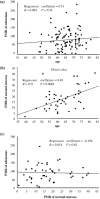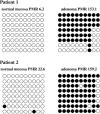Methylation of estrogen receptor 1 in colorectal adenomas is not age-dependent, but is correlated with K-ras mutation
- PMID: 19302287
- PMCID: PMC11159111
- DOI: 10.1111/j.1349-7006.2009.01140.x
Methylation of estrogen receptor 1 in colorectal adenomas is not age-dependent, but is correlated with K-ras mutation
Abstract
The promoter region of estrogen receptor 1 (ESR1) has been shown to be methylated in normal colorectal mucosa in an age-dependent manner. However, the methylation of this region in colorectal tumors has not sufficiently been investigated. The methylation status of ESR1 in 105 colorectal adenoma tissues was examined by MethyLight and presented as the percentage of methylated references (PMR). Factors that affect the PMR of ESR1 in adenomas were determined using parameters including patient age, sex, past history of malignancy, family history of colorectal cancer, smoking and drinking habits, clinical characteristics of adenomas (location, size, macroscopic appearance, and histology), and K-ras mutation. Multiple linear regression revealed that the PMR was not correlated with patient age. K-ras mutation was significantly correlated with the higher methylation status of ESR1 in adenoma (t-value = 3.21, P = 0.0018), whereas alcohol exposure was significantly correlated with lower methylation status (t-value = -2.37, P = 0.02). Because methylation of O6-methylguanine DNA methyltransferase (MGMT) has been reported to be correlated with K-ras G-to-A transition, methylation of ESR1 was compared with that of MGMT with regard to K-ras mutation. Contrary to expectations, methylation of MGMT was not significantly correlated with K-ras G-to-A transition, but that of ESR1 was strongly correlated with K-ras G-to-A transition. Thus, the methylation status of ESR1 in adenomas was not correlated with patient age, but was associated with K-ras mutation, suggesting that methylation of ESR1 in tumors functions differently from that in normal colon mucosa.
Figures




Similar articles
-
Methylation status of normal background mucosa is correlated with occurrence and development of neoplasia in the distal colon.Hum Pathol. 2010 Jan;41(1):38-47. doi: 10.1016/j.humpath.2009.06.002. Epub 2009 Sep 5. Hum Pathol. 2010. PMID: 19733896
-
Laterally spreading type of colorectal adenoma exhibits a unique methylation phenotype and K-ras mutations.Gastroenterology. 2006 Aug;131(2):379-89. doi: 10.1053/j.gastro.2006.04.027. Gastroenterology. 2006. PMID: 16890591
-
Hypermethylation of CpG island in O6-methylguanine-DNA methyltransferase gene was associated with K-ras G to A mutation in colorectal tumor.World J Gastroenterol. 2005 Apr 7;11(13):2022-5. doi: 10.3748/wjg.v11.i13.2022. World J Gastroenterol. 2005. PMID: 15800999 Free PMC article.
-
Inactivation of the DNA repair gene O6-methylguanine-DNA methyltransferase by promoter hypermethylation is associated with G to A mutations in K-ras in colorectal tumorigenesis.Cancer Res. 2000 May 1;60(9):2368-71. Cancer Res. 2000. PMID: 10811111
-
DNA alkylation and repair in the large bowel: animal and human studies.J Nutr. 2002 Nov;132(11 Suppl):3518S-3521S. doi: 10.1093/jn/132.11.3518S. J Nutr. 2002. PMID: 12421880 Review.
Cited by
-
MicroRNA expression profiles differentiate chronic pain condition subtypes.Transl Res. 2015 Dec;166(6):706-720.e11. doi: 10.1016/j.trsl.2015.06.008. Epub 2015 Jun 24. Transl Res. 2015. PMID: 26166255 Free PMC article.
-
A survey of methylated candidate tumor suppressor genes in nasopharyngeal carcinoma.Int J Cancer. 2011 Mar 15;128(6):1393-403. doi: 10.1002/ijc.25443. Int J Cancer. 2011. PMID: 20473931 Free PMC article.
-
Association of promoter methylation of ERα and ERβ with sporadic breast cancer--a study from North India.Tumour Biol. 2014 Aug;35(8):7911-9. doi: 10.1007/s13277-014-2052-4. Epub 2014 May 16. Tumour Biol. 2014. PMID: 24833090
-
Cliques for the identification of gene signatures for colorectal cancer across population.BMC Syst Biol. 2012;6 Suppl 3(Suppl 3):S17. doi: 10.1186/1752-0509-6-S3-S17. Epub 2012 Dec 17. BMC Syst Biol. 2012. PMID: 23282040 Free PMC article.
-
Targeted Bisulfite Sequencing Reveals DNA Methylation Changes in Zinc Finger Family Genes Associated With KRAS Mutated Colorectal Cancer.Front Cell Dev Biol. 2021 Oct 28;9:759813. doi: 10.3389/fcell.2021.759813. eCollection 2021. Front Cell Dev Biol. 2021. PMID: 34778269 Free PMC article.
References
-
- Baylin SB, Herman JG, Graff JR et al . Alterations in DNA methylation: a fundamental aspect of neoplasia. Adv Cancer Res 1998; 72: 141–96. - PubMed
-
- Esteller M, Risques RA, Toyota M et al . Promoter hypermethylation of the DNA repair gene O6‐methylguanine‐DNA methyltransferase is associated with the presence of G : C to A : T transition mutations in p53 in human colorectal tumorigenesis. Cancer Res 2001; 61: 4689–92. - PubMed
-
- Esteller M, Toyota M, Sanchez‐Cespedes M et al . Inactivation of the DNA repair gene O6‐methylguanine‐DNA methyltransferase by promoter hypermethylation is associated with G to A mutations in K‐ras in colorectal tumorigenesis. Cancer Res 2000; 60: 2368–71. - PubMed
-
- Shen L, Kondo Y, Rosner GL et al . MGMT promoter methylation and field defect in sporadic colorectal cancer. J Natl Cancer Inst 2005; 97: 1330–8. - PubMed
-
- Haydon AM, Jass JR. Emerging pathways in colorectal‐cancer development. Lancet Oncol 2002; 3: 83–8. - PubMed
MeSH terms
Substances
LinkOut - more resources
Full Text Sources
Medical
Research Materials
Miscellaneous

